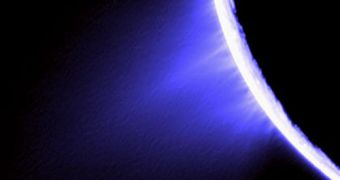In-depth analysis of a series of datasets collected by a NASA spacecraft last year revealed a surprising level of activity on and near the surface of the Saturnine moon Enceladus. The investigation was conducted on information collected on March 12, 2010, by the Cassini orbiter.
This spacecraft has been in orbit around Saturn since July 1, 2004, and has since conducted numerous flybys of the planet, its rings and its complex moon system. Titan and Enceladus are the most heavily studied of all Saturnine moons, as they are the weirdest.
Titan is covered in a thick, hazy atmosphere, that features all the necessary components for life. Its surface is covered in lakes of liquid hydrocarbons – such as methane and ethane – which makes it the perfect candidate to search for life in the solar system outside Earth.
But Enceladus is interesting from another point of view, and namely the fact that it could feature an ocean of liquid water deep underneath its crust. If that is the case, then it could harbor early lifeforms.
Experts say that the water, located under miles of ice, could be heated from the inside out, providing bacteria- and microbe-like microorganisms with the perfect environment to thrive and develop.
Also of interest on this moon are the geysers that develop at its South Pole. They release large amounts of water vapors and organic molecules, which contribute to feeding Saturn's E Ring. The fact that organic compounds are spewing out of the moon is extremely promising for astrobiologists.
Coupled with South Pole temperatures that are higher than theoretically predicted, this discovery again augments the chances of life existing beneath the frozen surface. The thickness of the ice shelves may also be protecting microorganisms from the harmful effects of cosmic radiation.
“A completely unexpected surprise is that the chemistry of Enceladus, what's coming out from inside, resembles that of a comet,” explains scientist Hunter Waite.
“To have primordial material coming out from inside a Saturn moon raises many questions on the formation of the Saturn system,” he goes on to sa.
The expert is the principal investigator for the Cassini Ion and Neutral Mass Spectrometer (INMS). He is based at the Southwest Research Institute (SwRI), in San Antonio, Texas, Daily Galaxy reports.
“Enceladus is by no means a comet. Comets have Tails and orbit the sun, and Enceladus' activity is powered by internal heat while comet activity is powered by sunlight. Enceladus' brew is like carbonated water with an essence of natural gas,” he says.

 14 DAY TRIAL //
14 DAY TRIAL //